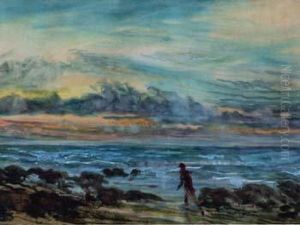William Edward Freeman Paintings
William Edward Freeman, born in 1870, was a British artist whose work spanned various mediums, including painting, printmaking, and illustration. His artistic journey began in the United Kingdom, where he cultivated his skills and developed a distinct style that would carry him through a career marked by both creativity and versatility.
Freeman received his formal art education at the prestigious National Art Training School, which later became the Royal College of Art. Here, he honed his abilities and was exposed to a range of techniques and artistic philosophies that would inform his later work. After completing his studies, he began to exhibit his work, participating in shows that would help to establish his reputation within the British art community.
Throughout his career, William Edward Freeman was recognized for his keen ability to capture landscapes and scenes of British life with a delicate balance of realism and romanticism. His paintings often depicted the English countryside, coastal scenes, and urban life with a sensitivity to light and atmosphere that evoked the works of the Impressionists, albeit with a distinctly British sensibility.
In addition to his paintings, Freeman was also a skilled illustrator and printmaker. His illustrations appeared in various publications, providing visual accompaniments to the literary works of the time. His prints, particularly his etchings and engravings, further showcased his technical ability and artistic range.
William Edward Freeman's contributions to the arts were not limited to his own creations. He was also involved in the art community as a teacher, sharing his knowledge and passion with younger generations of artists. His influence extended beyond his lifetime, as his students carried forward the techniques and inspirations they had gained from his tutelage.
Freeman's work was widely appreciated during his lifetime, and he was a regular exhibitor at galleries and artistic institutions. His legacy continued after his death in 1943, as his artworks remained in circulation, finding places in private collections and public institutions. Today, Freeman's work is considered part of the rich tapestry of British art history, offering a window into the visual culture of his time and the landscapes that he so adeptly captured.
